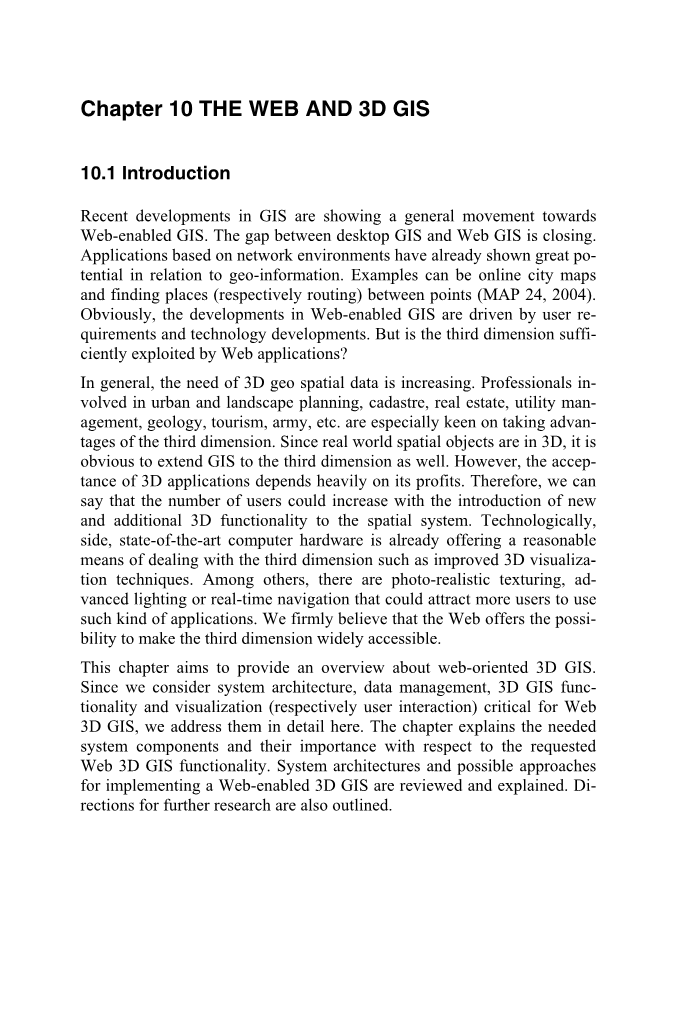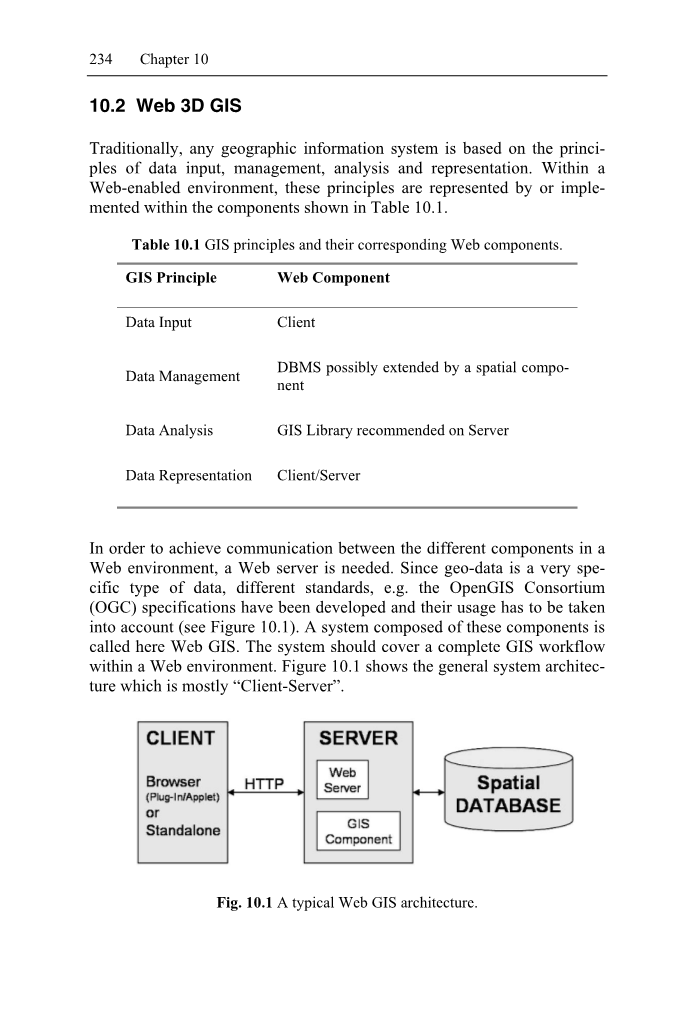英语原文共 23 页,剩余内容已隐藏,支付完成后下载完整资料
10.3 Management of 3D Spatial Data
In order to manage a 3D geo-information, at least the use of databases and their management systems (DBMS) are required. Object-relational modeling is the most common since relational databases are not very appropriate for storing spatial data. The object-oriented database approach faces the problem that the general acceptance and knowledge is not available so far(Connolly and Begg, 2002). The field of geo information adopts both approaches and comprises them into Object-Relational DBMS (Shekar andChawla, 2003). As stated in section 10.2, the additional integration of spatial extensions iS compilsory for GIS applications. Furthermore, because operations of 3D functionality are different from 2D, a reasonable concept of data storage is inevitable. Therefore, the two aspects of 3D geometry and 3D topology have to be taken into account. Geometry holds 3D coordinates of objects and topology holds their spatial relationships. The OGC proposes the separation between geonetry and topology within databases in order to perform certain queries on geonetry and topology (Oosterom etal, 2002). Regarding geometry, there are several DBMS available which have the ability to handle spatial data types. These data types are divided into geometric primitives of point, line and polygon. The OGC calls them simple features. However, 3D prinitives like polyhedrons are missing and have to be implemented individually. Stoter and Zlatanova (2003) showed how to store a polyhedron within Oracle 9i using multiple polygons.
In contrast to geometry, the topological part is more critical. The state-of-the-art DBMS does not offer any support for 3D topology. Shi et al,(2003) and Zlatanova et al., (2004) provide a brief overview about developed topological models including additional performance tests. Oracle recently announced the integration of topology up to 4D in its database spatial extens1onof Oracle 10g (Lopez, 2003). The corresponding OGC specification (complex feature specification), however, is yet to be completed - in terms of the implementation specifications for complex features.Topology is the base for reasonable querying of 3D spatial data. Since there is no unique topological model available, topology has to be imple-mented individually. Oosterom et al, (2002) provide an overview about available approaches. A spatial data model normally meant for a certain application (Zlatanova et al., 2002a) and a generic data model for general applications is hardly available. The technique of visualization is another factor for the question in selecting a topological model. Again, there is no general rule of the selection. Topological models should fulfill tasks such as covering all possible relationship and extensibility (Oosterom et al,2002).
Beside the geometry and topology, the spatial querying language for the third dimension poses a challenge for the database community as well.Giting (1994) concluded that in addition to SQL, a spatial query language has to provide fundamental spatial operations and reasonable ways of rep-resenting the results. Here, 3D operators on top of an ingenious data model are not available so far.
Spatial indexing is one main key to improve querying performance on geometric data - spatial objects are represented by indexes. Several different indexing methods are common but mainly R-tree, Quad-tree and P-tree are used. Furthermore, indexes are often used in conjunction with Level-of-Details (LOD) implementations (Coors, 2003; Kofler, 1998). Due to the fact that distributing within a Web environment has different requests on the volume of data, spatial objects must be as simple as possible while rep-resenting each object properly. Therefore, aspects of simplification and generalization have to be regarded as well when modeling 3D objects.Here, realistic photo-texturing is a common method to save resources.However, it has to be done patiently and it is necessary to store them efficiently. Furthermore, databases have to store the attribute information of 3D features as well.
10.4 GUI for 3D Visualization and Editing on the Web
In order to interact and communicate with information, a Graphical User Interface (GUI) has to be designed and created. A GUI is situated on top of the user agent. Because geographic information is usually very complex,this task is difficult to achieve. Moreover, the user interface is the most critical due to the fact that this is the “main gate” to the application. If a GUI is implemented poorly, an application will not be accepted by critical users. Compared to user interaction in 2D, a GUI for the third dimension is different (Coltekin, 2002).
To develop a GUI for 3D visualization, different aspects are important.First of all, the virtual world has to be sufficient. To do so, a set of core features of creating a 3D world are needed. The technique of visualization has to cover the state-of-the-art possibilities. In the case of 3D, these tech-niques include are reasonable modeling of physical objects, lighting and shadowing, definition of viewpoints, and photo-realistic texturing. As soon as interaction has to be involved, using events, linking and inter-nal/external scripting will become more important. In fact, 3D worlds in-cluding real-time interactive navigation are a requirement today. To ex-plore virtual worlds, a user would wants to be put into the space very closely. Therefore, characteristics similar to computer games are ve1y popular, for instance walkthrough, flying, panning and sliding. If the target is a singular object, rotating is another important real-time navigation at-tribute. More advanced characteristics of virtual worlds are Levels of De-tail (LOD) or multi-resolution texturing implementation. Furthermore,culling algorithms should be provided in order to make sure that invisible back-faces will not be rendered.Overall, the amount of ren
剩余内容已隐藏,支付完成后下载完整资料
资料编号:[257223],资料为PDF文档或Word文档,PDF文档可免费转换为Word
以上是毕业论文外文翻译,课题毕业论文、任务书、文献综述、开题报告、程序设计、图纸设计等资料可联系客服协助查找。
您可能感兴趣的文章
- GIS矢量地图的鲁棒水印方案外文翻译资料
- 中国相似地理位置发达地区房价影响因素的差异——以西安高新区和沣渭新区为例外文翻译资料
- 集成数据在城市土地利用变化时空动态监测的应用——以印度金奈都市为例外文翻译资料
- 全球地表水及其长期变化的高分辨率制图外文翻译资料
- 造成沿海大型城市内涝灾害的主要因素识别——以中国广州为例外文翻译资料
- 基于SFPHD框架的中国快速城市化地区城市生态系统健康综合评价方法外文翻译资料
- 基于绿地演变的未来城市地表热岛强度的多情景模拟预测外文翻译资料
- 中国大陆272个城市地面和冠层城市热岛强度的长期趋势外文翻译资料
- 与孟加拉湾热带气旋有关的中国低纬度高原远距离降雨事件外文翻译资料
- 新丰江水库流域GPM IMERG降水产品评价及水文效用研究外文翻译资料




